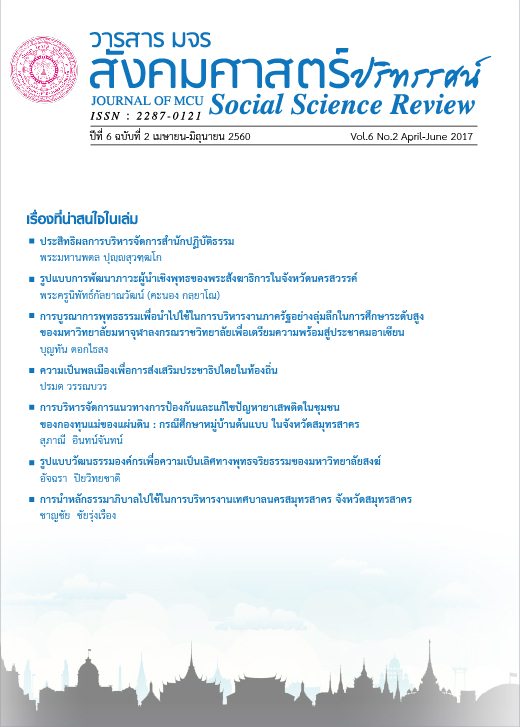รูปแบบวัฒนธรรมองค์กรเพื่อความเป็นเลิศทางพุทธจริยธรรม ของมหาวิทยาลัยสงฆ์
คำสำคัญ:
รูปแบบ วัฒนธรรมองค์กร ความเป็นเลิศ พุทธจริยธรรมบทคัดย่อ
การวิจัยฉบับนี้มีวัตถุประสงค์ คือ 1) เพื่อศึกษาแนวคิดทฤษฎี และหลักธรรมทางพุทธศาสนาในการส่งเสริมวัฒนธรรมองค์กรด้านความเป็นเลิศทางพุทธจริยธรรม 2) เพื่อศึกษาคุณลักษณะวัฒนธรรมองค์กรด้านพุทธจริยธรรมของมหาวิทยาลัยสงฆ์ 3) เพื่อนำเสนอรูปแบบวัฒนธรรมองค์กรสู่ความเป็นเลิศด้านพุทธจริยธรรมของมหาวิทยาลัยสงฆ์ ดำเนินการวิจัยโดยเป็นการวิจัยเชิงคุณภาพ เก็บข้อมูลจากผู้ให้ข้อมูลสำคัญโดยการสัมภาษณ์เชิงลึกจำนวน 25 รูป/คน ผู้ทรงคุณวุฒิด้านการสนทนากลุ่ม จำนวน 9 รูป/คน โดยการคัดเลือกแบบเจาะจง เครื่องมือที่ใช้ในการวิจัยครั้งนี้ คือ แบบสัมภาษณ์เชิงลึก และแบบการสนทนากลุ่มเฉพาะ โดยใช้การวิเคราะห์ข้อมูลแบบอรรถาธิบายและพรรณนาความ วิเคราะห์ลักษณะปัญหาจากเอกสาร จากการสัมภาษณ์ และจากงานวิจัยที่เกี่ยวข้อง ให้เห็นองค์ประกอบตามลักษณะของข้อมูลเชิงประจักษ์ โดยอาศัยข้อมูลเชิงคุณภาพมาประกอบการวิเคราะห์และสังเคราะห์ตามลำดับ การวิเคราะห์ข้อมูลจากการสนทนากลุ่มผู้เชี่ยวชาญ ใช้วิธีการตีความหมายในรูปแบบของการวิเคราะห์เนื้อหาเทคนิคกระบวนการวิภาษวิธี มี 4 ลักษณะคือ ลักษณะการยืนยัน ลักษณะปฏิเสธ ลักษณะยอมรับและปฏิเสธ และลักษณะหาข้อสรุปร่วม ซึ่งกระทำไปพร้อมๆ กันตลอดระยะเวลาที่ทำการวิจัย
ผลการวิจัยพบว่า
- แนวคิดทฤษฎี และหลักธรรมทางพุทธศาสนาในการส่งเสริมวัฒนธรรมองค์กรด้านความเป็นเลิศทางพุทธจริยธรรมพบว่า แนวคิดเกี่ยวกับวัฒนธรรมองค์กร วัฒนธรรมองค์กรเป็น ค่านิยม บรรทัดฐาน ความเชื่อ ประเพณี กรอบแนวคิด ธรรมเนียมปฏิบัติ มีอิทธิพลในการกำหนดพฤติกรรม ของสมาชิก และกลุ่มในองค์กร สมาชิกในองค์กรยึดถือ เป็นแนวทางปฏิบัติ ในการดำเนินการประจำวัน ภายในองค์กร ทั้งโดยทางตรงและทางอ้อม มีแนวคิดปลูกฝังค่านิยมขยายแนวคิดความเป็นเลิศขององค์กรสู่นานาชาติ ปัจจัยด้านวัฒนธรรมของมหาวิทยาลัยสงฆ์ที่จะนำองค์กรสู่ความเป็นเลิศพบว่ามีปัจจัยสำคัญ 4 ประการ ได้แก่ ความผูกพันและการมีส่วนร่วม การปรับตัวที่เหมาะสมเชิงบูรณาการ การประพฤติปฏิบัติได้สม่ำเสมอ มีวิสัยทัศน์และภารกิจขององค์กรที่เหมาะสม พุทธจริยธรรม เพื่อการประพฤติ การทำงาน และการอยู่ร่วมกันของบุคลากร เป็นหลักพุทธธรรมในพุทธศาสนา ที่ปรับประยุกต์ใช้กับหลักวิชาการสมัยใหม่ กลายมาเป็นจริยวัตรที่บุคลากรปฏิบัติประจำ ก่อให้เกิดความเชื่อและแนวปฏิบัติ มีการปฏิบัติอยู่ในหลักการของ ศีล สมาธิ ปัญญา
- คุณลักษณะวัฒนธรรมองค์กร ด้านพุทธจริยธรรมของมหาวิทยาลัยสงฆ์ พบว่า สมาชิกมีการปฏิบัติตามหลักไตรสิกขาซึ่งเป็นค่านิยมของมหาวิทยาลัย คือ มี ศีล สมาธิ ปัญญา
ในผู้นำองค์กร เป็นค่านิยมบุคลากรในการทำงานและอยู่ร่วมกัน คุณลักษณะพุทธจริยธรรมระดับพื้นฐานสมาชิกอย่างน้อย มีศีล 5 มีการคิดดีพูดดีทำดีต่อกันในระดับกลางมี กุศลกรรมบถ 10 ระดับสูงคือมีทางสายกลางเพื่ออะไรที่ตึงเกินไปหรือหย่อนเกินไป คือ มรรคมีองค์ 8 สมาชิกมีการปฏิบัติธรรมอย่างสม่ำเสมอ มีการศึกษาพระพุทธศาสนาบูรณาการกับศาสตร์สมัยใหม่ ความเป็นเลิศทางพุทธจริยธรรม บุคลากรมีความผูกพัน และการอยู่ร่วมกัน บุคลากรมีหลักธรรมการทำงานร่วมกัน องค์กรมีการถ่ายทอด ความเข้มแข็ง วัฒนธรรมสู่ภายนอก หลักธรรมนำการทำงานร่วมกันด้วยไตรสิกขา การเกื้อกูลและการเมตตากัน ซึ่งสอดคล้องกับพันธกิจและความเป็นอัตลักษณ์ของวัฒนธรรมองค์กรมหาวิทยาลัยมหาจุฬาลงกรณราชวิทยาลัย - รูปแบบวัฒนธรรมองค์กรสู่ความเป็นเลิศ ด้านพุทธจริยธรรมของมหาวิทยาลัยสงฆ์ ความสัมพันธ์ของพุทธจริยธรรม และวัฒนธรรมองค์กร ของมหาวิทยาลัยสงฆ์ องค์กรการศึกษาเป็นการศึกษาของสงฆ์ จึงมีพุทธจริยธรรมอยู่ข้างในเสมอ พุทธจริยธรรมที่สังเคราะห์มาเป็นแก่นของวัฒนธรรมองค์กร และเป็นวัฒนธรรมองค์กรขององค์กรการศึกษา โดยมีพุทธจริยธรรม 3 ระดับ
คือ ระดับพื้นฐาน ศีล 5 ระดับกลางกุศลกรรมบถ 10 และระดับสูงมรรคมีองค์ 8 ค่านิยมของบุคลากรคือไตรสิกขา ศีล สมาธิ ปัญญา เพื่อผู้นำองค์กร เพื่อบุคลากร เพื่อการทำงาน ความเป็นเลิศทางพุทธจริยธรรม มีความผูกพันและการอยู่ร่วมกันของบุคลากร ด้วยไตรสิกขา การทำงานร่วมกันของบุคลากร ด้วยความเกื้อกูลและเมตตากัน การถ่ายทอดวัฒนธรรมองค์กรที่เข้มแข็งสู่สังคมภายนอก คุณลักษณะกิจกรรมแบบอย่าง ผู้นำองค์กร ทำให้ดูอยู่ให้เห็น เป็นแบบอย่างที่ดี มีการปฏิบัติธรรม ของนิสิตทุกระดับ บุคลากรทุกคน เป็นประจำ มหาวิทยาลัยได้ทำบันทึกความร่วมมือ กับสถาบันการศึกษาทั่วโลก เพื่อการศึกษาพุทธธรรม มหาวิทยาลัยมหาจุฬาฯ เป็นศูนย์กลางพุทธศึกษานานาชาติ มีการจัดประชุมวิสาขบูชาโลกหลายปีต่อเนื่อง มีการร่วมมือกับคณะกรรมการป้องกันและปราบปรามการทุจริตแห่งชาติ จัดอบรม สัมมนา ความโปร่งใสในองค์กร
เอกสารอ้างอิง
Phraviman Kampeerapanyo (Trikamon). (2556). Analytical Study of Five Precepts as for the Foundation of Peace (Doctor of Buddhism Thesis) Hraduate School: Mahachulalongkornrajavidhyalaya University
Sentell, G.D., Fast. (1994). Focused & Flexible: Bold New Imperatives For The High Performance Organization, Michigan : Pressmark International.
Tippawan Lorsuwannarat. (2546). New Organization Theories. Bangkok: D,K.Printing World Ltd.
Yaowarin Srichainant. (2553). Organizational Culture: Network Creation and Ethical Development of Revenue Department, Ministry of Finance (Doctor of Philosophy Thesis) Graduate School, Mahasarakam University
ดาวน์โหลด
เผยแพร่แล้ว
รูปแบบการอ้างอิง
ฉบับ
ประเภทบทความ
สัญญาอนุญาต
ลิขสิทธิ์ (c) 2018 วารสาร มจร สังคมศาสตร์ปริทรรศน์

อนุญาตภายใต้เงื่อนไข Creative Commons Attribution-NonCommercial-NoDerivatives 4.0 International License.
เพื่อให้เป็นไปตามกฎหมายลิขสิทธิ์ ผู้นิพนธ์ทุกท่านต้องลงลายมือชื่อในแบบฟอร์มใบมอบลิขสิทธิ์บทความให้แก่วารสารฯ พร้อมกับบทความต้นฉบับที่ได้แก้ไขครั้งสุดท้าย นอกจากนี้ ผู้นิพนธ์ทุกท่านต้องยืนยันว่าบทความต้นฉบับที่ส่งมาตีพิมพ์นั้น ได้ส่งมาตีพิมพ์เฉพาะในวารสาร มจร สังคมศาสตร์ปริทรรศน์ เพียงแห่งเดียวเท่านั้น หากมีการใช้ภาพหรือตารางหรือเนื้อหาอื่นๆ ของผู้นิพนธ์อื่นที่ปรากฏในสิ่งตีพิมพ์อื่นมาแล้ว ผู้นิพนธ์ต้องขออนุญาตเจ้าของลิขสิทธิ์ก่อน พร้อมทั้งแสดงหนังสือที่ได้รับการยินยอมต่อบรรณาธิการ ก่อนที่บทความจะได้รับการตีพิมพ์ หากไม่เป็นไปตามข้อกำหนดเบื้องต้น ทางวารสารจะถอดบทความของท่านออกโดยไม่มีข้อยกเว้นใดๆ ทั้งสิ้น





